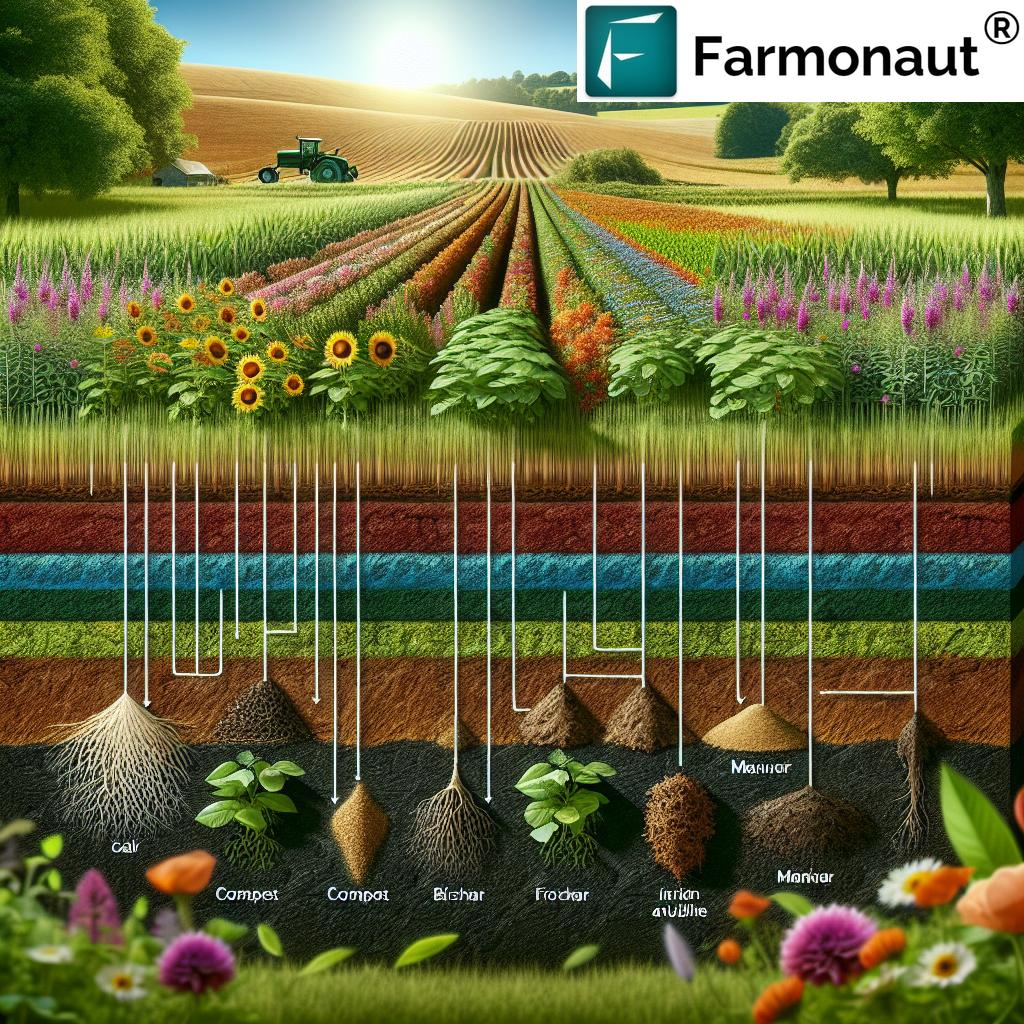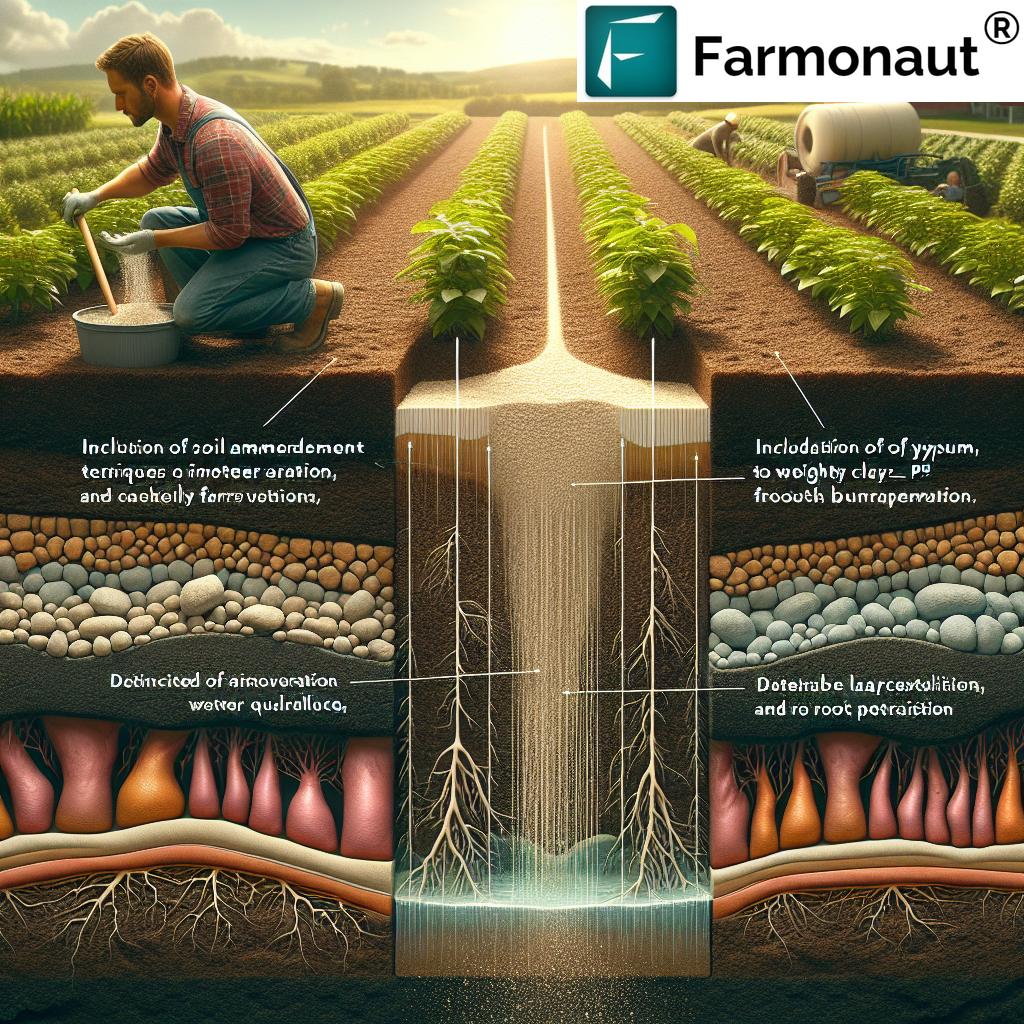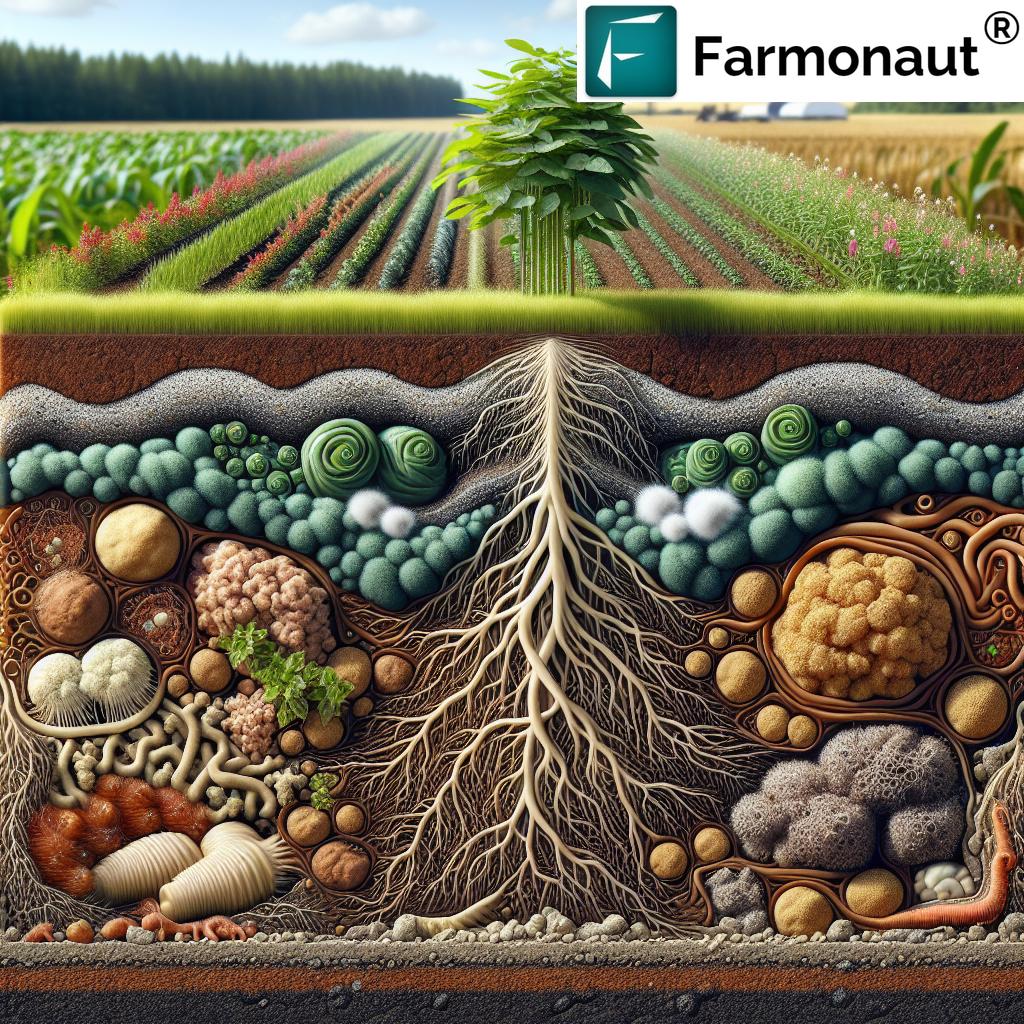Table of Contents
- What are Soil Amendments?
- Why are Soil Amendments Essential in Agriculture?
- Types of Soil Amendments
- Soil Amendments: 7 Shocking Ways to Supercharge Growth
- Comparative Benefits Table: 7 Key Soil Amendments
- Top Benefits of Soil Amendments
- Soil Amendment Application Methods
- Innovations in Soil Amendments
- Environmental Considerations and Sustainability
- Farmonaut’s Role in Enhancing Soil Health & Productivity
- Soil Amendments Frequently Asked Questions (FAQ)
- Conclusion
Soil Amendments: 7 Shocking Ways to Supercharge Growth
As we drive towards a more sustainable and productive future in agriculture, understanding soil amendments becomes absolutely essential. Whether in farming, forestry, or horticulture, the health, structure, and fertility of our soil profoundly impact plant growth and overall ecosystem sustainability. In this comprehensive guide, let us uncover the science, benefits, and shocking effectiveness of various soil amendments—showing how we can boost nutrient availability in agriculture, improve yields, and choose environmentally friendly practices that safeguard our future.
Why are Soil Amendments Essential in Agriculture?
Soil amendments are materials added to the soil to improve its physical, chemical, and biological properties. Their use is a strategic pillar for optimizing soil health, maximizing nutrient availability, and fostering sustainability across modern agriculture, farming, and forestry. By enhancing the structure of soils, enabling better water retention, and supporting essential microbial activity, proper soil amendment practices drive improved plant growth and agricultural productivity.
Let us explore how soil amendments bring transformative benefits and how their strategic management leads to healthier plants, enriched ecosystems, and greater environmental stewardship.
Types of Soil Amendments: Organic & Inorganic Solutions
Soil amendments are broadly categorized into two main types—organic soil amendments and inorganic soil amendments—with each serving distinct purposes in the management of soil health and plant growth.
Organic Soil Amendments
Organic amendments are derived from living organisms. They enrich the soil with essential nutrients and improve its structure and biological properties. Common examples include:
- Compost: This decomposed organic matter not only enhances soil fertility by providing essential nutrients, but also increases water retention, microbial activity, and improves soil structure.
- Manure: Sourced from animal excreta, manure is rich in key nutrients like nitrogen, phosphorus, and potassium. It’s renowned for boosting nutrient availability and supporting microbial life in the soil.
- Biochar: Produced through the pyrolysis of biomass, biochar is a form of charcoal with a remarkable ability to sequester carbon and improve soil fertility.
Inorganic (Mineral-Based) Soil Amendments
Inorganic amendments are typically mineral-based substances that address specific soil deficiencies and enhance physical properties of various soil types. Some popular choices include:
- Lime: Applied to raise soil pH (especially in acidic soils), thereby improving nutrient availability for many plants.
- Gypsum: Supplies calcium and sulfur; not only does it aid soil structure improvement and alleviate compaction, but also promotes water infiltration.
- Perlite: A volcanic glass that is heated until it “pops” into light, white nodules. Particularly valuable in heavy clay soils, it improves aeration and drainage.
Soil Amendments: 7 Shocking Ways to Supercharge Growth
Let’s spotlight the seven most impactful and sometimes surprising soil amendments and how their applications can dramatically increase plant growth naturally and enhance soil health across diverse agricultural ecosystems. Understanding these materials—their unique benefits, mechanisms, and best application strategies—will empower us to cultivate healthier plants and sustainable yields.
1. Compost: Transforming Organic Waste into Soil Gold
Compost stands as the cornerstone among organic soil amendments. By adding compost to soil, we introduce a balanced dose of decomposed matter rich in both macro- and micronutrients. This process encourages beneficial microbial activity, helps improve soil structure, boosts fertility, and enables higher water retention.
- Benefits: Provides balanced nutrient availability in agriculture, suppresses disease, and increases soil’s ability to retain moisture.
- Application Tips: Incorporate compost into the top 6–8 inches of soil pre-planting for best effects.
- Environmental Impact: Reduces landfill waste, sequesters carbon, and enriches the soil ecosystem.
2. Manure: Harnessing the Power of Animal Excreta
Manure, especially when well-composted, provides a rich source of nitrogen, phosphorus, potassium, and vital micronutrients. It is used to enrich soil, improve nutrient cycling, and foster microbial diversity. Care must be taken to avoid fresh manure application, which may introduce pathogens or excessive salts.
- Benefits: Encourages robust plant growth, enhances biological soil properties, and increases soil fertility.
- Application Tips: Apply decomposed manure pre-season, mix thoroughly for uniform nutrient distribution.
- Environmental Impact: Promotes circular agriculture and reduces reliance on synthetic fertilizers.
3. Biochar: Carbon Lock-in for Enhanced Soil Health
Biochar is created by burning biomass such as crop residues in an oxygen-limited environment (pyrolysis). As a stable form of charcoal, it not only captures carbon but also supports soil structure improvement and fosters microbial activity.
- Benefits: Increases soil fertility, moderates pH, enhances moisture retention, and stores carbon long-term.
- Application Tips: Mix into soils at 5–10% by volume; can be combined with compost for maximum effect.
- Environmental Impact: Sequesters carbon, mitigating greenhouse gas emissions; improves resilience.
Looking to improve your farm’s sustainability and environmental footprint? Discover Farmonaut’s Carbon Footprinting tools—enabling data-driven tracking of your on-field emissions and fostering a greener, more sustainable agricultural ecosystem.
4. Lime: The Key to Soil pH Adjustment
Lime—including agricultural lime (calcium carbonate)—is used to raise soil pH in acidic soils. Many crucial nutrients are “locked up” and unavailable to plants at low pH levels. By adjusting pH upward, lime dramatically improves nutrient availability and root health.
- Benefits: Corrects acidic soil, boosts nutrient uptake for crops like legumes, and enhances beneficial microbial processes.
- Application Tips: Spread and incorporate lime based on soil testing recommendations; avoid over-application.
- Environmental Impact: When well-managed, reduces reliance on costly fertilizers and supports soil health.
Need expert advice on soil amendment application methods, plantation, and forestry? Get real-time, satellite-based guidance with Farmonaut’s Crop, Plantation & Forest Advisory platform—ideal for optimizing nutrient inputs, pH, and environmental stewardship.
5. Gypsum: Resolving Compaction & Salinity Issues
Gypsum (calcium sulfate) is unique among soil amendments for its capacity to add calcium and sulfur without raising soil pH. It’s highly effective for soil structure improvement, breaking up heavy clay and alleviating compaction. This improves water infiltration and assists in leaching excessive sodium in saline soils.
- Benefits: Improves soil aeration, structure, and root penetration, supporting healthier plants.
- Application Tips: Spread uniformly and till into affected soil layers for best results.
- Environmental Impact: Helps reclaim degraded soils and remediates saline/sodic conditions.
6. Perlite: Aeration Specialist in Heavy Soils
Perlite is a volcanic glass that pops into lightweight granules when super-heated. Its porous nature increases aeration and drainage—making it an invaluable amendment for heavy clay soils and for potting mixes requiring improved physical soil properties.
- Benefits: Prevents waterlogging, facilitates root growth, and enhances oxygen exchange.
- Application Tips: Mix 10–30% perlite by volume for in-ground beds or containers.
- Environmental Impact: Sterile and weed-free; increases efficiency in water usage.
7. Vermicompost: Boosting Microbial and Nutrient Dynamics
Vermicompost is produced by worms digesting organic matter. This “supercharged” compost contains high levels of beneficial microbes, plant growth hormones, and nutrients in plant-available forms—making it especially noteworthy in organic soil amendments.
- Benefits: Boosts soil fertility, microbial activity, and enhances plant immunity.
- Application Tips: Top-dress around crop roots or blend into planting beds; suitable for all crops.
- Environmental Impact: Recycles food/agricultural waste, reduces chemical dependence, and increases sustainability.
Comparative Benefits Table: 7 Key Soil Amendments
| Amendment Name | Main Components | Est. Improvement in Soil Health (%) | Est. Increase in Nutrient Availability (%) | Sustainability Score (1-5) | Typical Application Methods |
|---|---|---|---|---|---|
| Compost | Decomposed organic matter, microbial biomass | 35% | 32% | 5 | Incorporate into soil before planting, side-dress |
| Manure | Animal excreta, organic nitrogen, phosphorus, potassium | 29% | 28% | 4 | Spread and till in pre-season, composted for safety |
| Biochar | Carbon-rich charcoal from pyrolyzed biomass | 25% | 15% | 5 | Mixed with soil or combined with compost |
| Lime | Calcium carbonate or oxide | 20% | 27% | 3 | Broadcast and incorporate by tilling |
| Gypsum | Calcium sulfate | 21% | 11% | 4 | Apply to surface, till into compacted clay or saline soils |
| Perlite | Expanded volcanic glass | 16% | 6% | 4 | Mix with clay soils or potting media |
| Vermicompost | Worm-processed humus, organic nutrients | 32% | 27% | 5 | Top-dressing, blended into root zones |
Top Benefits of Soil Amendments
The benefits of soil amendments extend well beyond immediate yield gains, laying the foundation for long-term sustainability and ecosystem resilience. Among their outstanding advantages are:
- Soil Structure Improvement: Amending soil addresses compaction, increases aggregation, and dramatically boosts water infiltration and root penetration. Better soil structure creates an optimal environment for plants to thrive.
- Enhanced Nutrient Availability: Key nutrients like nitrogen, phosphorus, and potassium become more accessible, fueling healthier plants and higher productivity.
- Boosted Water Retention: Organic amendments such as compost and biochar significantly increase soil moisture retention, thus reducing irrigation needs and supporting growth during droughts.
- pH Adjustment for Crop Suitability: Amendments like lime or sulfur adjust pH to suit the needs of different crops, correcting nutrient imbalances and maximizing uptake.
- Promotion of Beneficial Microbial Activity: Many organic amendments stimulate the growth and activity of helpful soil microbes, fostering a self-sustaining, disease-resistant ecosystem.
- Improved Soil Health: With a strategic mix of amendments, it’s possible to increase plant growth naturally, drive up yields, and build truly resilient soils.
These benefits accrue over seasons, compounding into healthier fields, higher profitability, and more robust environments for generations to come.
Soil Amendment Application Methods: Maximizing Impact
Soil amendment application methods are crucial to realizing the full effects of the materials we add. The right methods ensure optimal distribution, minimize waste, and maximize beneficial impact. Here’s how we can supercharge the effectiveness of soil amendments:
1. Soil Testing: The Foundation of Success
Always begin with thorough soil testing. This identifies nutrient deficiencies, pH levels, and specific needs. Precision is key: test by field, zone, or plot to tailor amendment application.
2. Incorporation & Mixing
For most amendments—particularly compost, lime, gypsum, and manure—it’s best to incorporate them into the soil before planting. This ensures even distribution, prevents surface runoff, and enhances root accessibility.
3. Top-Dressing & Side-Dressing
Vermicompost or mature compost can be evenly raked onto the soil surface as a top-dress. Crops benefit from side-dressing amendments during active growth to target critical nutrient delivery periods.
4. Choosing the Right Timing
Apply soil amendments in sync with crop cycles: pre-planting for overall soil structure improvement and mid-season to boost nutrient availability during leaf and fruit development.
5. Rate Calculations and Avoiding Over-Application
Carefully calculate application rates based on test results and manufacturer recommendations. Over-application can harm soil health and pollute water sources.
Access Farmonaut’s advanced AI-based farm advisory system (read more here) for data-driven suggestions on when and how to apply soil amendments, tailored to your fields, crops, and local environmental conditions.
Innovations in Soil Amendments: Advancing Sustainable Agriculture
As we pursue sustainability, agricultural productivity is being transformed by new technologies and innovative soil amendment materials. Let’s look at where the future is heading:
- Hydrogels: These superabsorbent polymers retain and slowly release water, enhancing resilience in drought-prone zones while reducing loss to evaporation.
- Engineered Nanomaterials: The use of nano-fertilizers enables targeted, efficient nutrient delivery, reducing environmental impact and minimizing input expenses.
- AI-Driven Decision Support: Utilizing real-time satellite imagery and advanced analytics from platforms like Farmonaut, we can monitor soil health and optimize amendment timing, selection, and application for every hectare—empowering even smallholder farmers to benefit from precision agriculture.
To integrate soil and crop advisory tools into your existing tech stack, view the Farmonaut API or dive into the Farmonaut API Developer Docs.
Large growers and agribusinesses can streamline operations, nutrient management, and crop monitoring at scale with Farmonaut Large Scale Farm Management.
Environmental Considerations and Sustainability
As we accelerate the pace of soil amendment adoption, we must also remain vigilant about minimizing environmental risks and maximizing sustainable outcomes.
1. Avoiding Over-Application and Pollution
Excess nutrients (e.g., nitrogen or phosphorus) can leach into waterways, leading to eutrophication or algal blooms. Over-application of amendments may also disturb critical soil pH balances or degrade structure.
- Regular soil testing prevents excess application of nutrients or amendments.
- Rotating amendment types and application intervals reduces accumulation and risk.
2. Making Sustainable Amendment Choices
Whenever feasible, select renewable, responsibly sourced amendments. For instance, coconut coir is a sustainable alternative to peat moss, and compost or vermicompost utilize organic waste streams.
3. Traceability and Environmental Compliance
Traceability isn’t just important for food production—it’s also critical for compliance, financing, and consumer trust. Farmonaut’s blockchain-based product traceability solution (see details) ensures every product’s sustainability story is fully traceable from origin to market.
4. Reducing Chemical Dependency and Carbon Footprint
Widespread use of organic soil amendments is proven to reduce reliance on synthetic fertilizers and pesticides, cutting emissions and agricultural runoff. For advanced reporting and compliance, check Farmonaut’s Carbon Footprinting tools.
Robust resource management tools are available for both fleet management (learn more) and crop loan and insurance verification (know how), helping sustain operations while keeping environmental goals at the forefront.
Farmonaut’s Role in Enhancing Soil Health & Productivity
Farmonaut is redefining agricultural productivity and sustainability by making advanced satellite-based farm management accessible for everyone—from smallholders to large-scale agribusinesses and government agencies.
- Satellite-Based Crop Health Monitoring: Multispectral imagery measures soil moisture, NDVI, and plant health—helping optimize soil amendment application and reduce resource wastage.
- Jeevn AI Advisory System: Delivers personalized, real-time recommendations for managing soil health, maximizing yields, and improving input efficiency.
- Blockchain Traceability: Ensures supply chain transparency and compliance with sustainability standards.
- Resource and Fleet Management: Enhances operational efficiency, reduces environmental impact, and ensures compliance with environmental regulations.
To empower your fields using technology, get started with Farmonaut today on the web, Android, or iOS.
Soil Amendments Frequently Asked Questions (FAQ)
What are soil amendments, and why do they matter so much in agriculture?
Soil amendments are materials added to soil to improve its physical, chemical, or biological properties. They are essential for optimizing soil structure, enhancing nutrient and water availability, supporting healthy microbial activity, and ultimately increasing plant growth and agricultural productivity.
How do I know which amendment my soil needs?
Begin with a comprehensive soil test to identify nutrient deficiencies, pH imbalances, and structural issues. The test results guide you in selecting the most appropriate amendment(s) for your farm, whether compost, lime, gypsum, or others.
Can over-application of soil amendments be harmful?
Yes. Excessive application may create nutrient imbalances, harm soil biology, disturb pH, and lead to pollution of nearby water bodies. It is critical to follow tested recommendations and monitor soil responses annually.
Are organic amendments always better than inorganic?
While organic amendments offer sustainability and ecosystem benefits, inorganic amendments are invaluable for correcting specific soil deficiencies. The best approach combines the strengths of both, tailored to your land’s needs.
What impact do amendments have on water retention?
Amendments like compost, biochar, and vermicompost significantly increase soil moisture retention. They allow soils to hold more water for longer periods, reducing irrigation frequency and building drought resilience.
How can technology help in soil amendment management?
Platforms like Farmonaut use satellite imagery, AI-driven advisory, and blockchain-based traceability to optimize soil amendment application, monitor ongoing soil health, and support compliance and sustainability goals across all farm sizes.
Conclusion: Building a Sustainable Future through Soil Amendments
The strategic use of soil amendments lies at the very heart of sustainable agriculture. By understanding and harnessing both organic and inorganic amendments—from compost and manure to lime, gypsum, and new innovations—we can improve soil fertility, optimize nutrient availability, and ensure lasting agricultural productivity.
With technological advances like satellite crop monitoring, AI-powered recommendations, and blockchain traceability offered by platforms such as Farmonaut, we have the opportunity to supercharge growth, protect our natural resources, and champion a more resilient future. Empower your farm with informed soil management—let’s nurture the foundation of our food systems, together.
Embrace the benefits of soil amendments today—and take the first step towards healthier soil, thriving plants, and a sustainable legacy for generations to come.




















